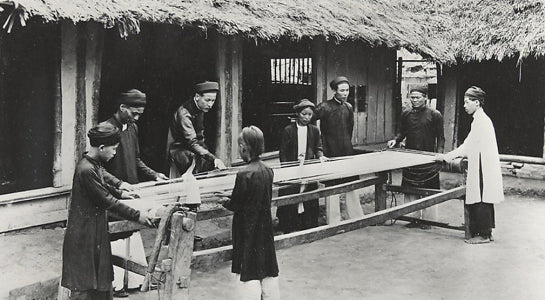Threads of Empire: Vietnamese Silk in the Age of French Colonization

Share
Vietnamese silk has long been known for its softness, breathability, and natural beauty. But while much attention is paid to its ancient origins or modern revival, an equally defining chapter lies in the colonial silk industry — when French colonization (1887–1954) dramatically influenced the trajectory of silk production in Vietnam. This era marked the collision of two worlds: one rooted in tradition and craftsmanship, the other driven by European fashion markets, industrialization, and imperial ambition.
A Colonial Commodity: Why the French Sought Vietnamese Silk
By the late 19th century, silk had become a symbol of luxury and refinement across Europe. In France especially, silk was closely tied to haute couture, interior design, and aristocratic culture. Demand for silk was enormous — not just from domestic production centers like Lyon, but also from colonies that could supply high-quality raw silk at lower cost.
Vietnam, with its centuries-old tradition of silk weaving and an ideal climate for mulberry cultivation, quickly became a focus of colonial planners. Provinces like Hà Đông, Nam Định, and An Giang were recognized as major centers of silk production, and the French integrated them into the colonial silk industry as part of their broader imperial economy.

Silk was no longer just a cultural or ceremonial fabric, it had become a colonial commodity, positioned for export, refinement, and re-entry into the European luxury market.
French Fashion Influence and the Rise of Export
As the French influence on silk deepened, so did Vietnam’s role in the global textile market. In the early 20th century, the booming Parisian fashion industry spurred interest in exotic and artisanal materials. Although Vietnam did not produce silk at the scale of China or Japan, the sheen, durability, and softness of Vietnamese mulberry silk gained popularity among French designers and merchants.
Colonial administrators encouraged the use of Vietnamese silk in home décor, formalwear, and uniforms while simultaneously exporting large quantities of raw and woven silk to France. Some of this silk was processed locally in colonial trading houses, while other batches were refined in textile mills in Lyon.
French tastes also began influencing the aesthetics of Vietnamese silk. Floral motifs, symmetrical layouts, and Western-inspired color palettes were introduced in weaving villages to suit European interior and fashion preferences. In this way, Vietnamese silk evolved from a strictly traditional fabric into an item with global, export-oriented appeal.
Silk Production Changes: Technique and Modernization
One of the most impactful shifts during colonization was the change in how silk was made. The French, with their background in industrial textile production, brought new tools and methods to Vietnam. These silk production changes included:
-
Hybrid silkworm breeds: Cross-bred silkworms were introduced to improve yield and consistency, though some artisans believed the silk lacked the softness of native strains.
-
Synthetic dyes: Traditional Vietnamese dyes made from indigo, betel, and mặc nưa fruit were replaced or supplemented with aniline dyes, offering brighter, more predictable results.
-
Jacquard looms: Semi-mechanized looms enabled more complex patterns and quicker output, introducing new forms of woven design into the Vietnamese silk landscape.

Yet full-scale industrialization never fully took hold. Vietnam’s silk sector remained centered in small, artisan-run villages, where most silk was still produced by hand. Unlike in Japan, where silk factories thrived, Vietnam’s silk economy was geared toward semi-finished export rather than domestic manufacturing.
Traditional vs. Industrial Silk: A Divided Path
The contrast between traditional vs. industrial silk was stark and lasting.
|
Traditional Silk |
Colonial-Influenced Industrial Silk |
|
Handmade on wooden looms |
Semi-mechanical Jacquard looms |
|
Natural, plant-based dyes |
Synthetic aniline dyes |
|
Small batch, seasonally dependent |
Higher volume, export-focused |
|
Passed down through family generations |
Often learned through colonial training |
|
Deeply tied to local customs and ceremonies |
Market-driven, tailored to foreign demand |

Traditional Vietnamese silk retained its softness, irregularity, and spiritual connection - each piece telling a story of its maker. Meanwhile, the industrial model pursued consistency, uniformity, and efficiency for foreign markets. Yet many weavers blended the two approaches, using new dyes while preserving loom traditions or adjusting patterns to suit European tastes.
Silk Trade History Under the French
The silk trade history of colonial Vietnam reveals an intricate network of commerce beyond just France. While Lyon remained the central processing hub, Vietnamese silk was also exported to:
-
North Africa (Algeria, Morocco) via broader French colonial trade
-
Japan and China, especially specialty silk like black-dyed Tân Châu silk
-
The Netherlands and Belgium, showcased in international trade exhibitions
-
Overseas Vietnamese communities, where silk served as a cultural link to the homeland
More than numbers or destinations, the most lasting effect of this trade was symbolic: Vietnamese silk became recognized as an international product, shaped by global demand but still rooted in artisanal identity.
Resistance, Identity, and Craft Preservation
Despite efforts to standardize silk production, many Vietnamese artisans resisted the loss of tradition. Some refused to adopt chemical dyes; others remained loyal to indigenous silkworm breeds. Weaving villages became subtle centers of cultural resistance — places where identity was expressed not through slogans, but through quiet, careful hands.
Today, many of the most respected silk artisans can trace their lineage back to families who preserved traditional methods during colonization. Their continued work is a reminder that resilience often lives in the thread itself.
Legacy of the Colonial Silk Industry
Even decades after the French left, traces of the colonial silk industry remain in Vietnam:
-
Some French weaving patterns and dyeing techniques are still used in Hà Đông and other villages
-
The presence of Jacquard looms in niche workshops reflects early 20th-century modernization efforts
-
The fusion of Western aesthetics with Vietnamese craftsmanship laid the groundwork for modern designers like Kilomet109, Gamme Collective, and others who export Vietnamese silk in contemporary forms
Most importantly, the colonial period brought Vietnamese silk into the international imagination. It encouraged producers to think beyond village walls, to see their craft as something worthy of global attention — and global respect.
The French colonial era reshaped the Vietnamese silk industry in complex ways. It brought exposure, innovation, and access to new markets — but also pressure, extraction, and cultural compromise. Yet through it all, Vietnamese silk endured, sustained by artisans who kept weaving even as the world around them changed.
Today, its legacy continues — not just in the fabric, but in the balance between adaptation and preservation.




